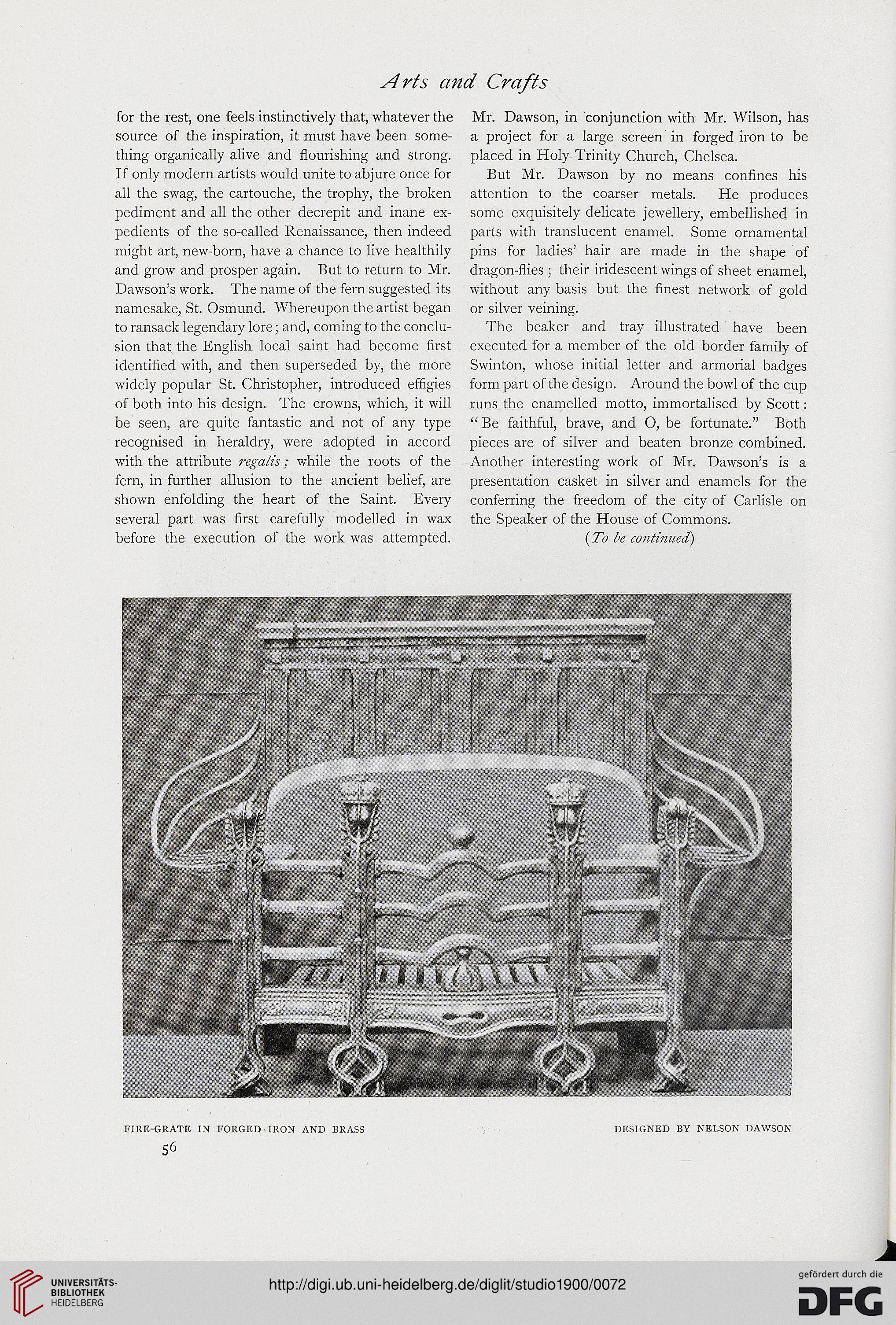Arts and Crafts
for the rest, one feels instinctively that, whatever the
source of the inspiration, it must have been some-
thing organically alive and flourishing and strong.
If only modern artists would unite to abjure once for
all the swag, the cartouche, the trophy, the broken
pediment and all the other decrepit and inane ex-
pedients of the so-called Renaissance, then indeed
might art, new-born, have a chance to live healthily
and grow and prosper again. But to return to Mr.
Dawson's work. The name of the fern suggested its
namesake, St. Osmund. Whereupon the artist began
to ransack legendary lore; and, coming to the conclu-
sion that the English local saint had become first
identified with, and then superseded by, the more
widely popular St. Christopher, introduced effigies
of both into his design. The crowns, which, it will
be seen, are quite fantastic and not of any type
recognised in heraldry, were adopted in accord
with the attribute regalis; while the roots of the
fern, in further allusion to the ancient belief, are
shown enfolding the heart of the Saint. Every
several part was first carefully modelled in wax
before the execution of the work was attempted.
Mr. Dawson, in conjunction with Mr. Wilson, has
a project for a large screen in forged iron to be
placed in Holy Trinity Church, Chelsea.
But Mr. Dawson by no means confines his
attention to the coarser metals. He produces
some exquisitely delicate jewellery, embellished in
parts with translucent enamel. Some ornamental
pins for ladies' hair are made in the shape of
dragon-flies ; their iridescent wings of sheet enamel,
without any basis but the finest network of gold
or silver veining.
The beaker and tray illustrated have been
executed for a member of the old border family of
Swinton, whose initial letter and armorial badges
form part of the design. Around the bowl of the cup
runs the enamelled motto, immortalised by Scott:
" Be faithful, brave, and O, be fortunate." Both
pieces are of silver and beaten bronze combined.
Another interesting work of Mr. Dawson's is a
presentation casket in silver and enamels for the
conferring the freedom of the city of Carlisle on
the Speaker of the House of Commons.
{To be continued)
FIRE-GRATE IN FORGED IRON AND BRASS
56
DESIGNED BY NELSON DAWSON
for the rest, one feels instinctively that, whatever the
source of the inspiration, it must have been some-
thing organically alive and flourishing and strong.
If only modern artists would unite to abjure once for
all the swag, the cartouche, the trophy, the broken
pediment and all the other decrepit and inane ex-
pedients of the so-called Renaissance, then indeed
might art, new-born, have a chance to live healthily
and grow and prosper again. But to return to Mr.
Dawson's work. The name of the fern suggested its
namesake, St. Osmund. Whereupon the artist began
to ransack legendary lore; and, coming to the conclu-
sion that the English local saint had become first
identified with, and then superseded by, the more
widely popular St. Christopher, introduced effigies
of both into his design. The crowns, which, it will
be seen, are quite fantastic and not of any type
recognised in heraldry, were adopted in accord
with the attribute regalis; while the roots of the
fern, in further allusion to the ancient belief, are
shown enfolding the heart of the Saint. Every
several part was first carefully modelled in wax
before the execution of the work was attempted.
Mr. Dawson, in conjunction with Mr. Wilson, has
a project for a large screen in forged iron to be
placed in Holy Trinity Church, Chelsea.
But Mr. Dawson by no means confines his
attention to the coarser metals. He produces
some exquisitely delicate jewellery, embellished in
parts with translucent enamel. Some ornamental
pins for ladies' hair are made in the shape of
dragon-flies ; their iridescent wings of sheet enamel,
without any basis but the finest network of gold
or silver veining.
The beaker and tray illustrated have been
executed for a member of the old border family of
Swinton, whose initial letter and armorial badges
form part of the design. Around the bowl of the cup
runs the enamelled motto, immortalised by Scott:
" Be faithful, brave, and O, be fortunate." Both
pieces are of silver and beaten bronze combined.
Another interesting work of Mr. Dawson's is a
presentation casket in silver and enamels for the
conferring the freedom of the city of Carlisle on
the Speaker of the House of Commons.
{To be continued)
FIRE-GRATE IN FORGED IRON AND BRASS
56
DESIGNED BY NELSON DAWSON




